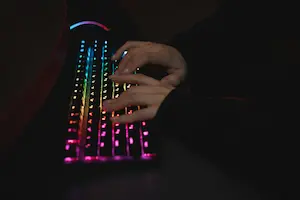You don’t need to spend hundreds to get satisfying keystrokes and a reliable feel. This guide walks you through how to choose a mechanical keyboard that fits your needs, from gaming to work, while keeping things budget-friendly.

Image: Pexels – Tima Miroshnichenko
CONTENTS
show
⌨️ Step 1: Pick Your Switch Type First
The feel of your keyboard starts with the switches. Choose:
- Linear (Red): Smooth and quiet – great for gaming
- Tactile (Brown): Light bump – good for mixed use
- Clicky (Blue): Audible click – for typists who love feedback
💡 Step 2: Decide on Keyboard Size
Full-size has everything. Tenkeyless (TKL) removes the number pad. 60% or 75% layouts are compact but skip function keys. Go for what fits your desk and workflow best.
🎯 Pro Tip: Smaller boards leave room for your mouse arm – great for FPS players and minimalist setups.
🎮 Step 3: Look for Must-Have Features, Not Extras
Anti-ghosting, RGB lighting, and USB-C are great but avoid paying extra for advanced macros or software if you won’t use them. Focus on build quality and switch performance first.
🧰 Step 4: Consider Hot-Swappable Boards
Want to experiment later? Some budget keyboards are hot-swappable, meaning you can change switches without soldering. A nice-to-have for future-proofing your setup.
💵 Step 5: Stick to Reputable Budget Brands
Brands like Redragon, Keychron, Royal Kludge, or Tecware offer high-value mechanical keyboards without inflating costs. Check reviews for quality control and key feel.
💡 Smart Budget Tips for Mechanical Keyboards
- Start with a TKL board to save space and money
- Brown or red switches are best for all-around use
- Don’t overpay for RGB, most budget boards have it standard
- Always read switch reviews, the feel matters more than specs
- Check Reddit or keyboard forums for hidden gems
🔗 Related How-To Guides:
⌨️ You don’t need a $200 keyboard to enjoy mechanical magic. With the right layout, switch, and features, you can get pro-level performance for a fraction of the price.

